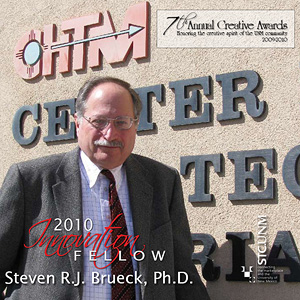 As the recipient of the first annual STC.UNM Innovation Fellow Award, no one better exemplifies the spirit of innovation than Dr. Steven Brueck. A prolific inventor who holds 28 issued patents at UNM, beginning in 1989 at an impressive pace of 1-2 patents almost every year, and with many more pending patents in the pipeline, his technologies have been licensed to major companies and promising start-ups.
As the recipient of the first annual STC.UNM Innovation Fellow Award, no one better exemplifies the spirit of innovation than Dr. Steven Brueck. A prolific inventor who holds 28 issued patents at UNM, beginning in 1989 at an impressive pace of 1-2 patents almost every year, and with many more pending patents in the pipeline, his technologies have been licensed to major companies and promising start-ups.
Dr. Brueck is also Director of the School of Engineering’s Center for High Technology Materials (CHTM); he acts as both a collaborator with esteemed colleagues and as a mentor to countless graduate students. His technical and administrative leadership has created a community of multidisciplinary researchers, tenured professors and students alike, whose collaborations have produced 65 patents and 8 start-up companies. The more than 350 graduate students who have studied at CHTM and received advanced degrees have taken that innovative spirit with them to local and national companies and the national labs. CHTM’s work spans a wide range of research fields concentrated in the areas of nanoscience, optoelectronics and microelectronics. Dr. Brueck and his fellow investigators work with lasers, semiconductors and materials the size of protein molecules to develop faster ways to transmit data, build smaller circuits, create nano-based biomedical devices and produce more efficient LED technology.
Dr. Brueck’s main research focus is on the process of nanolithography, a way of replicating patterns on the atomic or molecular scale. His lithographic technologies are able to pattern smaller and smaller features on silicon wafers. They are leading to faster, smaller, lighter and more mobile applications. In 2006, he and his team created the smallest pattern on record at 45 nanometers (1 nanometer is 1 billionth of a meter). At the time, the electronics industry manufactured at the 90 nanometer level.
The uniqueness and usefulness of his research is that it extends over the entire process of nanolithography—from creating the nano tools and lenses used to make the patterns to the chemical substances used on the substrates. As Dr. Brueck has observed, nanolithography is “an enabling technology” because the applications are conceivably limitless for such fields as semiconductors, biotechnology, lighting and materials science.
The economic and social impact of these discoveries is readily apparent. The commercialization of Dr. Brueck’s technologies has produced 9 license and option agreements to companies and start-ups. Because research in industry labs has been scaled back dramatically in the last 20 years, new technologies created in university labs are critically important to maintaining U.S. leadership in innovation and product production. This valuable intellectual property will save the electronics and semiconductor industries millions of dollars in manufacturing costs. The applications of his microfluidics technology currently being developed by licensees could give doctors more accurate and specific tests and treatment plans and patients better outcomes.
CHTM’s stature is growing and is recognized by national and international organizations for its high quality research. The Center participates in the National Nanotechnology Infrastructure Network (NNIN)—a National Science Foundation initiative to facilitate user access to laboratories at 13 universities. Through NNIN, companies come to the Center to use its labs, which provide some of the best resources in the country for nanotechnology-related work. CHTM has also been designated a Center of Excellence by SEMATECH, the international semiconductor manufacturers association whose mission is to partner with universities and other organizations in the search for new materials, tools and processes.
The return on the investment made by the New Mexico Legislature when it appropriated funding for the creation of CHTM is more than 12 times that appropriation in the number of grants, contracts, new companies and new jobs produced by the Center. The network of collaborations and relationships that Dr. Brueck’s leadership and creative accomplishments has established is a tangible asset. His “enabling technology” is a technological achievement that will “enable” all of us to reap the benefits for decades to come.

